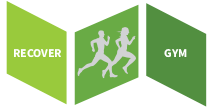Runner’s back / single sided iliopsoas syndrome / tendinopathy
Rehab for the injury
Rehab mobility and stability – Rehab strength training
Please consider working out the rest of your body, so that you won’t lose any current mobility, stability or strength. – Figure out what workouts you can do and workout in accordance to your capability. By training the rest of your body, you’ll also accelerate the healing of your injury, partially because of increased nerve activity and circulation.
Description
Iliopsoas syndrome can be divided into two types. A double sided type which is also called Runners’ back and a one sided type, which is often confused with groin injuries.
The Iliopsoas muscle originates from the front of the vertebrae as well as the inside of the hip socket, and attaches on the inside, on the top of the femur. Its main function is to bend the hip, which can strain it in most types of sports where running is included.
If you have had Runner’s back, you typically have pain over the lower back when the muscle is cold. This means that for the first kilometers of a run, your back hurts. When the muscle then gets warm, the muscle becomes longer and more flexible and the pain disappears. But when you have finished running and have been in the shower, etc., the pain begins again. The paradox is that running aggravates the problem, but it is precisely during running that the pain subsides. One will often see an excessive lumbar sway as the muscle pulls the back forward. The treatment is mainly exercise therapy, which aims to reduce the “resting pressure” in the muscle.
Symptoms
- Lower back pain and / or back pain at the start of a workout and after a workout.
- Pain most often seen with severe hip stretching; eg. running, hence the name “Runner’s back”.
- Excessive sway can cause discomfort / pain at night and in the morning.
Diagnosis
- Thomas test. Lie on your back and grab one knee with both hands and then pull it as far up to the chest as possible. The other leg should now lie relaxed without bending at the knee.
- Examination of the lumbar spine.
- Conversation about the symptoms.
Treatment
- Use the Rehab methods to build mobility, stability and strength in the pelvis, to counteract lumbar sway and pelvic rotation.
- Heat treatment
- Muscle energy technique and other by a Manual Therapist, Sports Injury Therapist or Physiotherapist.
- Spascupreel (2 tablets 3 g. Daily for 9 days) as a muscle relaxant.
- Kinesiology tape
Note: The muscle is in every way too deep to be massaged, although some therapists treat the iliac muscle (part of the iliopsoas) along the hip ridge. This has little or no effect as the muscle covers the entire inner hip socket and cannot be considered treated by grasping the outermost centimeters.

Social Medier